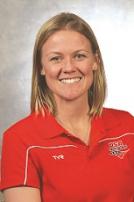
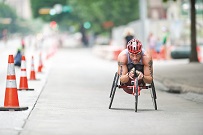
The Numbers Are Only Going Up
More people with physical challenges are discovering multisport events and USA Triathlon is definitely seeing an increase in participation. In the past three years since the announcement was made that paratriathlon would be included in the Paralympic Games in Rio for the first time, we have seen a 500% increase in participation. Every week, we get calls from paratriathletes who are interested in finding races in their backyard, or from race directors who want to make their events more accessible. It’s our goal at USA Triathlon to help events become accessible, and to help the athletes find those events.
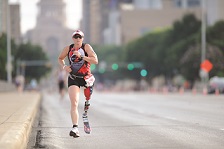 Beyond ADA
Beyond ADA
We know all about the Americans with Disabilities Act but we have really written our own rules and best practices when it comes to planning events. For example, for events where you will have a number of paratriathletes, you may need larger amounts of handicap-accessible parking spaces and portable bathrooms than are mandated by ADA. We’re always looking at paratriathlons to see what athletes need and what’s acceptable, and we’re constantly asking ourselves – and the athletes – what we can do better. It’s an ongoing education, not just for the event planners, but for us.
Keeping Events User-Friendly
We want all athletes to have a good experience, from start to finish. For example, we know that multisport athletes travel with a lot of gear – bicycles, wetsuits, running shoes, etc. If you’re a paratriathlete, you’re going to need someone’s help to move all that gear out of your car and to put all of it exactly where it needs to be.
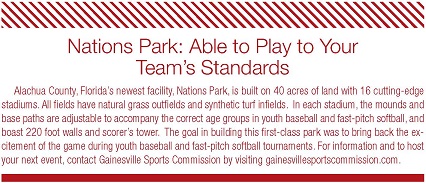 Something we’ve learned is that paratriathletes need help at transition points during the event. We tell event organizers that we need what are called handlers – those are volunteers who work with individual athletes and get them set up and help them get ready for their next segment after they complete the one before. That calls for a lot of coordination between the athlete and the handler – deciding where to meet, where and how to get their transition spot set up, what they need help with. It’s very detailed. After the event, the athlete is going to need help getting everything back to the car whenever they’re ready to do that.
Something we’ve learned is that paratriathletes need help at transition points during the event. We tell event organizers that we need what are called handlers – those are volunteers who work with individual athletes and get them set up and help them get ready for their next segment after they complete the one before. That calls for a lot of coordination between the athlete and the handler – deciding where to meet, where and how to get their transition spot set up, what they need help with. It’s very detailed. After the event, the athlete is going to need help getting everything back to the car whenever they’re ready to do that.
In general, the easier you can make it for the athlete, the more accommodating you can be to them, the more likely you are to have that athlete want to come back to your event, or maybe even to participate in another one. You’re not actually just working to increase participation in your event; you’re working to keep them involved in multisport in the future. You’re also creating a reputation for your event as a desirable experience. The disabled world is actually a community and it’s very close-knit. If an athlete is happy with the way something went, he or she will tell friends and pretty soon, you will have a whole lot of people who are interested in participating too.
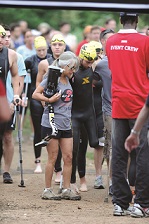 Volunteers are Key
Volunteers are Key
The volunteers an event director can recruit to help out with an event make all the difference in the world. We have worked to make it easy for volunteers to understand in advance what is going to be involved by creating a document called the Handler Operations Manual. It has Frequently Asked Questions and it lists the things a volunteer can be expected to do.
Being a handler is a very physical job. We like to have a designated set of volunteers to help with the swim. They need to know they’re going to get wet and that at times, they will be totally submerged. For larger events, we will do a whole educational session on how to get a swimmer out of the water at the exit. The athletes will backstroke up, and the volunteers have to be right there in the water to grab them and pull them out and put them in their wheelchair to get them to the transition point. Or, if the athlete is an amputee, it’s likely they’ll need someone to lean on so that they can hop to that transition point.
It’s also the handler’s job to help the paratriathlete get his or her wetsuit off. Stripping a wetsuit off is an art form if you’re able-bodied. We want them to know how to do it correctly because we don’t want to make the athlete lose time in the race and we don’t want them to block other people from getting out of the water and moving to the transition point.
Being this type of volunteer is a very hands-on job but people do find it incredibly rewarding. Our largest event in the U.S. is in Austin, Texas. Our first year there, we recruited volunteers to help out. They had a blast and immediately signed up to work the following year. It was great for them because they could see how much their jobs impacted the athletes. That’s part of why we keep going back there – the volunteer base is so strong.
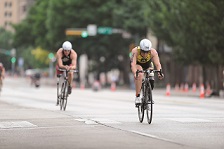 Willing Event Directors
Willing Event Directors
The other part of what makes a race accessible is having an event director who genuinely wants it to be accessible. It doesn’t just happen. Having an event for paratriathletes definitely takes some thinking and advance planning. Not everyone wants to put that kind of time into a race for what might be only a few people. Those who do, though, have the most accessible races. It comes down to being aware of the extra things you need, having the volunteers in place and really, just being welcoming to everyone.
At USA Triathlon, we have what is called a paratriathlon-friendly application that race directors can fill out. It’s a 14-page questionnaire about their race. If their event is paratriathlon-friendly, it gets official approval from us for their website. That really helps paratriathletes who are looking for those events; they don’t have to call up the event organizers and explain ‘I’m an amputee’ or ‘I’m in a wheelchair.’
Ancillary Events
If you’re holding banquets or events for athletes after the race, you also need to consider how they’re going to be set up. If you are using a stage, make sure the stage has a ramp so people who are using wheelchairs or other devices can get up there. The podiums should have ramps too. When we did our first accessible triathlon, we forgot about the podiums and had to apologize to the participants who couldn’t get up on them. Now, accessible podiums are on our checklist. If you are holding a dinner, there should be enough space around the tables and between them to accommodate wheelchairs.
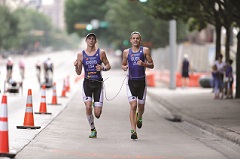 When it comes to hotels and guest rooms, we don’t really have problems in this country. When we do events internationally, we often have to make special arrangements with individual hotels. When that happens, I’ll get a list of arrangements the hotel is willing to make, and I’ll e-mail a wheelchair athlete and ask if that’s acceptable to them.
When it comes to hotels and guest rooms, we don’t really have problems in this country. When we do events internationally, we often have to make special arrangements with individual hotels. When that happens, I’ll get a list of arrangements the hotel is willing to make, and I’ll e-mail a wheelchair athlete and ask if that’s acceptable to them.
The Paratriathlon Experience
Accessible triathlons are unique. The able-bodied athletes are out there competing on the same course as the paratriathletes. It inspires both kinds of athletes. You work harder and you go faster because you’re right next to the person who’s an amputee or who is pedaling a handcycle. Not a lot of other Paralympic sports have that inclusive aspect. We’re glad we’re able to provide it.

